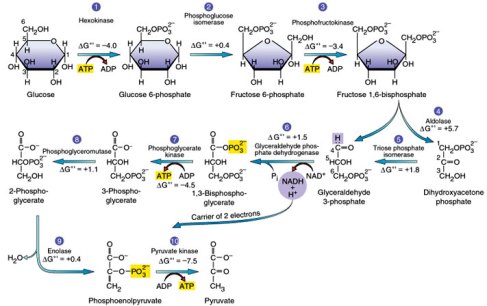-Hexokinase takes the terminal from ATP to add to glucose-6-phosphate
-Every cell has glucose transporters. By phosphorylating glucose-6 phosphate, the glucose cannot move but by adding phosphate to glucose, it becomes unstable (abit) and activated which promotes reaction.
-Phosphofructokinase-1 is the most regulated enzyme followed by hexokinase in glycolysis.
-Bisphosphate has 2 phosphates not attached to the same carbon as in diphosphate.
-Aldolase does the splitting where G3P and DP are isomers of each other.
-DHAP does not contiune in glycolysis.
-TPI converts DHAP to G3P so you get 2 molecules of G3P at the end of the prep-phase.
-TPI is a kinetically perfect enzyme.
-All kinases require Mg2+ as a cofactor because it stabilizes the charge on the ATP molecule.
-All enzymes have an induced fit to prevent water from hydrolysing ATP.
-Oxidation phase in the pay-off section is energetically feasible.
-Oxidation provides energy to phosphates to form 1-3-BPG(2) amd would be unfeasible without oxidation.
-Gylcolysis cannot go on without NAD+ (low conc. in cells)
-3ways to get ATP: substrate-level phosphorylation, oxidative phosphorylation and photo-phosphorylation in plants.
-1-3 BP is a very high energy molecule.
-Most ATP comes form Oxidative phosphorylation.
reference:
David L. Nelson, Michael M. Cox. Lehninger Principles of Biochemistry. New York: W. H.
Freeman and Company, 2008.



Thanks to your blog loaded with so numerous information. Stopping by your blog helped me to have what I was searching for.
Usually I don’t write-up on blogs, but I need to say that this write-up very forced me to do so! Thanks, quite nice article.